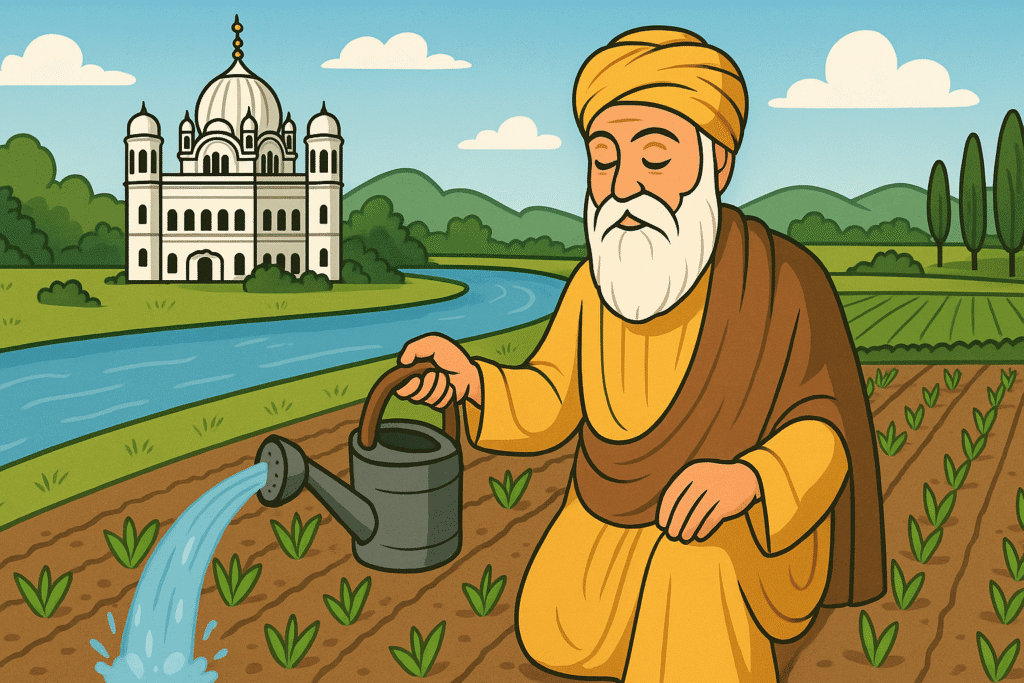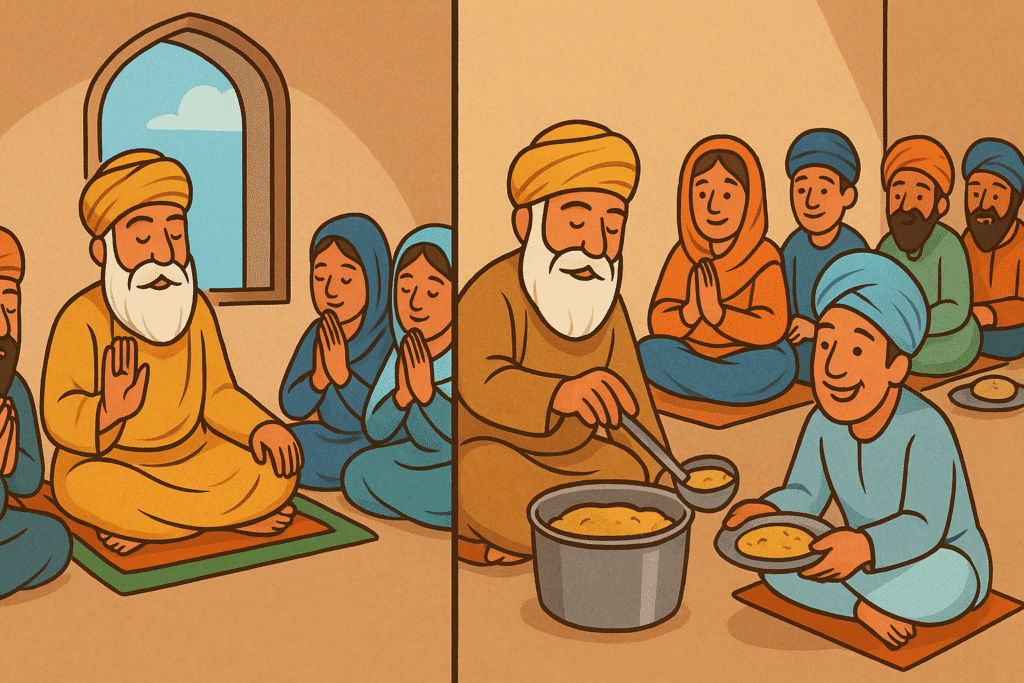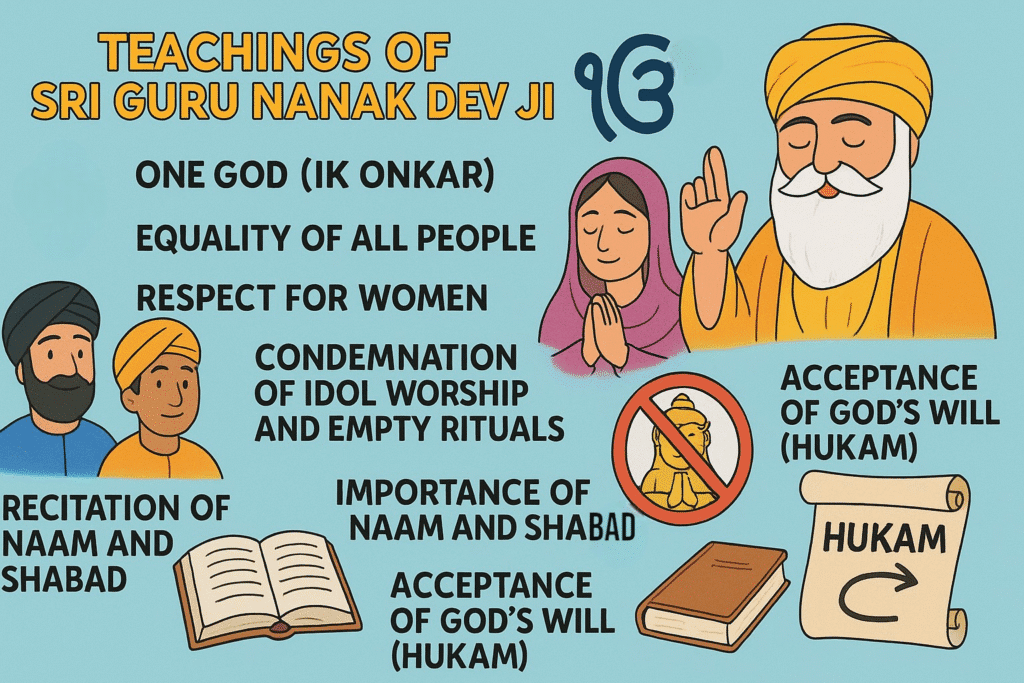
After completing his three long journeys—known as Udasis —from Punjab to the south of Ceylon (Sri Lanka), through the Hill states, Kashmir, Hasan Abdal, and finally towards the east of Mecca and Medina, Sri Guru Nanak Dev Ji returned from his travels.
We learned about these three Udasis in our previous article. Afterward, he decided to settle down permanently. In 1521 A.D., he founded a new town on the banks of the River Ravi and named it Kartarpur, which means “the abode of God.”
During his Udasis , Guru Nanak had a deep impact on people across different parts of the world. He successfully reached out to many communities, teaching them the values of love, compassion, and devotion to one God. As a result, many people became his followers by adopting a life centered around truth and divine love.
In this article, we will discuss the final phase of Sri Guru Nanak Dev Ji’s life, between the years 1521 and 1539 A.D.
Table of Contents
Foundation of Kartarpur
Sri Guru Nanak Dev Ji founded the city of Kartarpur in 1521 A.D. on the banks of the River Ravi. The name Kartarpur literally means “the abode of God.”
After settling there, many followers began to visit him regularly. At Kartarpur, he established two important institutions:

- Sangat :
This was a daily gathering where people came together to listen to the Guru’s hymns (Bani ). Anyone could join, regardless of caste, gender, or religion. In this gathering, everyone would recite the name of the One God. - Pangat :
This meant sitting together in a line to share food (Langar ) without any discrimination based on caste, gender, or creed. This practice showed unity among people at a time when society was deeply divided.
These two institutions were powerful tools for spreading the message of love, equality, and brotherhood. Guru Nanak taught that all human beings are children of the same God.
Besides these institutions, Sri Guru Nanak Dev Ji also composed many Shabads (hymns). There are 976 hymns attributed to him in the Guru Granth Sahib . These hymns played a key role in spreading and strengthening Sikhism during a time when injustice and oppression were widespread.
Choosing the Second Guru of Sikhism
As Sri Guru Nanak Dev Ji grew older, he began thinking about who would continue his spiritual mission after his passing.
He chose Bhai Lehna Ji , a devoted follower from the Trehan Khatri family. Bhai Lehna was known for his tireless service, deep devotion, and unwavering faith in the teachings of the Guru.
Guru Nanak placed a coconut and five copper coins before Bhai Lehna and bowed before him with great respect. From that moment, Bhai Lehna became Sri Guru Angad Dev Ji , the second Guru of Sikhism.
This was an important decision. By choosing a worthy successor over his own sons, Guru Nanak established a new tradition in Sikhism—leadership based on merit and spiritual dedication, not birthright.
This decision gave a new direction to the Sikh movement. It laid the foundation for future Gurus and helped Sikhism grow into a strong and organized faith, culminating in the leadership of the Tenth Guru, Sri Guru Gobind Singh Ji.
🔹 To explore more articles on English Grammar and strengthen your language skills for competitive exams, click here.
Departing to the Eternal World
Sri Guru Nanak Dev Ji left this world on 22 September 1539 A.D. in Kartarpur, on the banks of the River Ravi. His passing marked the end of his earthly journey but also the beginning of a spiritual awakening among the people.
He held a special place in history—not only in India, but across the world—for his teachings of love, peace, and justice.
After his death, his body vanished, leaving behind only ashes. Both Hindus and Muslims revered him deeply. Hindus considered him a holy sage and wished to perform his last rites according to Hindu customs. Muslims regarded him as a saint and wanted to follow Islamic traditions.
When they lifted the cloth covering his body, they found only flowers and ashes. His body had disappeared, proving that he belonged to all humanity beyond religious boundaries.
At the site where his ashes were found, a beautiful temple called Gurdwara Darbar Sahib Kartarpur was later built in his honor.
Gurdwara Darbar Sahib Kartarpur
The Gurdwara Darbar Sahib Kartarpur is located in Narowal District, Punjab Province, Pakistan. It is the final resting place of Sri Guru Nanak Dev Ji.
At this place, Guru Nanak lived peacefully and cultivated his own vegetables using water drawn from the River Ravi. After the Partition of India in 1947, Kartarpur became part of Pakistan. It lies just about 5 kilometers from the Indian border.
In 2019, both India and Pakistan agreed to establish a corridor—known as the Kartarpur Corridor —to allow Indian pilgrims to visit the Gurdwara without needing a visa. This allows devotees to travel to the sacred site for a day visit, making it easier for them to pay their respects.
🔹 For more insightful articles and updates on current affairs, feel free to explore our website through this link.
Teachings of Sri Guru Nanak Dev Ji
Sri Guru Nanak Dev Ji taught people across the world with simple yet powerful words. His teachings left a deep and lasting impression on the hearts of many—from rulers like Malik Bhago to thieves like Sajjan Thug, whom he transformed through love and wisdom.
His message was not limited to any one group—it was for all of humanity.
Some of the key teachings of Guru Nanak include:

- One God (Ik Onkar) : There is only one God, formless and eternal.
- Equality of All People : He condemned the caste system and promoted equal respect for all.
- Respect for Women : He opposed the ill-treatment of women and upheld their dignity.
- Condemnation of Idol Worship and Empty Rituals : He believed in inner spirituality rather than outward displays of religion.
- Recitation of Naam and Shabad : Remembering God and singing His praises brings peace and enlightenment.
- Importance of the Guru : A true spiritual teacher guides us toward truth and righteousness.
- Acceptance of God’s Will (Hukam) : We should live in harmony with the divine plan.
🔹 Explore the vibrant history and culture of Punjab, from its ancient roots to its modern traditions, by diving into our detailed articles—click here to learn more!
From 1521 to 1539 A.D., Sri Guru Nanak Dev Ji lived in Kartarpur and built a peaceful, united community based on love, equality, and service. He introduced Sangat and Pangat to break down social barriers and promote unity.
He also chose a worthy successor, ensuring that his spiritual mission would continue after his passing.
Even today, his final resting place—Gurdwara Darbar Sahib Kartarpur —remains a symbol of his enduring legacy.
His teachings remain relevant even now, reminding us to live with compassion, treat everyone equally, and always seek truth and justice. More than 500 years after his passing, the light of Guru Nanak continues to shine brightly in the hearts of millions across the world.
